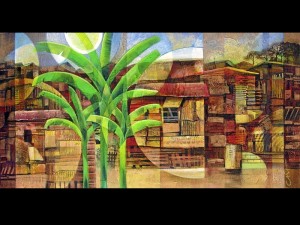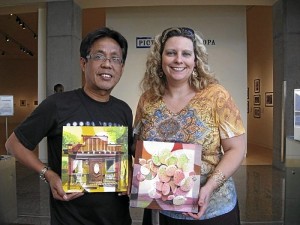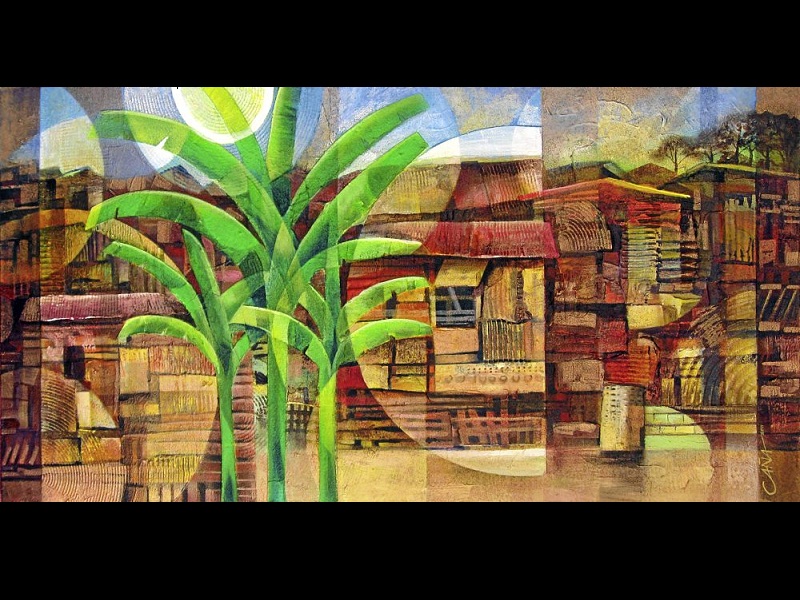
LOS ANGELES – Something about Caña’s art simply tugs at the heart.
You gaze at his “Mother and Child” and you can feel the warmth, love, tenderness and peace of the subjects. His “Kaleidoscope Barung-barong” – a constant in his art because he grew up seeing all those shanties everyday as a kid living in Kamuning, Quezon City – conveys joy and hope, nonetheless, as he adds a touch of green to the brown landscape.
His acrylic on canvas rendition of “Ondoy, Cross-over,” which he did after seeing the unity that brought Filipinos together during the Ondoy calamity, dramatically shows images of people getting together, their arms locked in a shared task, and somehow, in the midst of all of this, a cross is formed.
Franklin Valencia, the man who signs his art “Caña” (his middle name), was born in Calauag, Quezon and grew up in Kamuning, Quezon City. His fascination with the fragmented images began on the streets of Kamuning, at the age of 10, when time was mostly spent playing marbles with his friends. As he looked at the little glass orbs against the sun, the kaleidoscopes that they created, prisms of light and colors that formed half-moons, mesmerized the young boy.
“I used to live on Judge Jimenez Street in Kamuning and near that street, there were many shanties, mga barung-barong sa tabi ng sapa (by the creek),” the 53-year-old artist recalled. “At a young age, I was already doing kaleidoscope renderings. I never won in any poster-making contests because my paintings were different. When I played with my marbles and held them against the light, my imagination ran wild. Every time I looked at them, I felt happy.”
“Naglalaro sa isip ko na masaya ang mundo sa ganda ng mga kulay. Di ko naiisip na mahirap kami. Alam ko masaya ako pag sumisilip ako sa holen. At yon, pag wala akong magawa, yung mga natatandaan kong images dino-drawing ko [I saw how colorful and beautiful the world was, through marbles. I didn’t even notice that we were poor. I peered into the marbles and felt happy. And that’s also what I enjoyed drawing].”
“When I became a painter, the half-moons became my way of rendition,” he said. “I always challenge my friends when they view my paintings. I ask them, ’So how many half-moons do you see in my painting?’”
The half- moon shapes and patterns, the play of shadows and light, the beautiful shapes that looked like the letters C and D, in hindsight, became the wellspring of Caña’s visual language. A language through which he now makes his presence felt, not only in the local scene but internationally as well, as he conquers Hong Kong, New York, Los Angeles, San Francisco, Arizona and soon Singapore.
What makes Caña’s art special is his unique way of drawing out the beauty in the ordinary, of finding serenity in the crazy, of discovering the joy in the lonely, of bringing out poetry in the day-to-day scenery.
A member of the prestigious Saturday Group, Caña’s works appear regularly in the Group’s art exhibits, and he serves as one of the organization’s officers.

This low-profile but highly respected award-winning artist earned his Bachelor of Fine Arts degree, major in Advertising, from the University of Santo Tomas. But he did not pursue his present calling immediately after graduation. Instead, he traveled halfway around the globe to Jeddah, where he worked as a Graphic Designer for Jeddah Graphic Center, a leading publication and graphic design company in the Kingdom of Saudi Arabia.
He did get a chance to do some painting, and even reaped awards there as his painting won high honors in the First Saudi Arabia Painting Competition in 1992. And in 1994, he became the only Filipino participant in the Al Mahmal Third International Artists Exhibition. While abroad, he also co-founded the Pinta-Pilipino, an association of Filipino artists based in Jeddah.
Married to the former Ma. Teresa Servida with whom he has four children, Caña returned to the Philippines after 11 years in Jeddah, and in 1994 joined J. Romero and Associates. Capitalizing on Caña’s expertise and talents, J. Romero established its own design studio, Quadra Graphics, with Caña as head.
It was his elder brother, watercolorist Magoo Valencia, who encouraged him to pursue his real passion for painting, and in 2001, he made the leap from advertising and joined the Saturday Group.
“Natauhan ako,” he said. “I retired after two years – I took early retirement. Kasi parang trend ’yan. A lot of well-known painters like H. R. Ocampo, Joya and Legaspi, just to name a few, all came from advertising.”
After making the move, he began pouring all his artistic energies into his paintings, and it was then that he felt “the true joy of painting.” It was also at the Saturday Group where Caña met Malang who became his close friend and mentor.
He recalled that his first painting session with the Saturday Group was on still life. Malang asked Magoo to bring Caña’s finished work to the former’s gallery. It was sold in two days.
At their next group exhibit in Subic, Caña was the highest seller, and the elders of the group immediately told Malang about it. It was Malang who advised Magoo to tell his brother to sign his paintings as “Caña,” his middle name, to distinguish him from his older brother, who was already signing his painting as Valencia.
“I think Malang, who is actually Mauro Malang Santos, wanted me to use my middle name too like him,” Caña said. After that, the two became the best of friends. To Caña, Malang is a father, a friend, a big brother and a spiritual leader. “He brought me closer to God,” Caña admitted.
Despite all the attention that he is fast gaining, Caña remains humble and unaffected. “I am a simple man,” he is always quick to say.
The artist displays his aggressiveness, however, in his art as he continues to experiment with diverse media, including watercolor, airbrush, charcoal and pastel. As such, Caña’s art continues to evolve and grow, to excite and make one ponder, to believe and to feel.
Caña admitted that he does not do paintings to make political statements. “But I have works that have social relevance like my ‘Ondoy, Cross-over’ or my ‘Barung-barong,’” he said. “They are related to the daily things that I see or feel about my environment. Some of my peers tell me that I should not paint poverty. But I am not afraid to paint what I love to paint. Plus, when you look at my ‘Barung-barong’ paintings, you won’t feel degraded or feel low. You would see patterns, order in chaos, as they say. Since I grew up seeing them everyday when I was young, these images are probably embedded in my heart.”

Aside from the “Barung-barong” series, another of the artist’s favorite themes is vendors. It is, after all, a world familiar to him. “Kasi naranasan kong maglako ng tinapa kasama ang late father ko (I’ve experienced hawking smoked fish in the streets with my father),” he shared. Other times, it was selling vegetables in the market with an older sister, or ice candy and bread. “Yon, Pinoy na Pinoy ang feeling ko doon. Masa akong tao – laking Kamuning (I’m thoroughly Pinoy, mass-based, Kamuning-bred).”
Recently, Caña went to the US to join a 12-man group exhibit in New York for four Filipino community events, namely: Independence Day (June 5), Philippine Day (June 12), Fil-Am Friendship Day (June 26) and Philippine Fiesta (August 20).
“I just left behind some of my work because I couldn’t stay until August 20. But they want me to hold a one-man exhibit next year at the Philippine Center,” he said.
From New York, he proceeded to San Francisco and Los Angeles. And then it was on to Arizona, where he donated two paintings for the Third Annual 10 x 10 Benefit Show, the proceeds of which would go to the Mesa Contemporary Arts Exhibitions and educational programs.
“I did it because I learned I would be the first Filipino painter to join them if I made it to their exhibit next year,” Caña said. “They invited me to submit my resume for a possible exhibit next year. I am anxious because the competition is tough. There are 20 jurors and nobody has even heard of me.”
Well, not yet, perhaps, but pretty soon! •














































